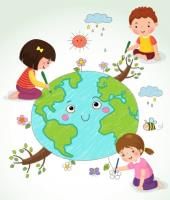Class 2 Exam > Class 2 Questions > Please add opposites and one many for all cha...
Start Learning for Free
Please add opposites and one many for all chapters?
Most Upvoted Answer
Please add opposites and one many for all chapters?
**Opposites and One Many for All Chapters**
Opposites play a crucial role in language learning as they enhance vocabulary and help in understanding the meaning of words better. Similarly, the concept of one and many is vital in developing a child's understanding of quantity and number. In Class 2, there are various chapters that introduce these concepts to students. Let's explore each chapter and discuss the opposites and one many related to them in detail.
**Chapter 1: Our Universe**
In the chapter "Our Universe," students learn about celestial bodies, day and night, and seasons. Some opposites related to this chapter include:
- Day and night: Opposite in terms of light and darkness. Day refers to the time when the sun is visible, while night is the period of darkness when the sun is not visible.
- Summer and winter: Opposite seasons where summer represents hot weather, while winter signifies cold weather.
One many related to this chapter can be the concept of stars. Students learn that there are many stars in the universe, emphasizing the vastness of the celestial world.
**Chapter 2: Our Earth**
The chapter "Our Earth" focuses on the planet we live on and its various features. Some opposites related to this chapter include:
- Land and water: Opposite in terms of solid and liquid. Land refers to the surface of the Earth, while water represents the bodies of water like oceans, rivers, and lakes.
- Day and night: Similar to the concept in the previous chapter, day represents when the sun is visible, while night signifies darkness.
One many related to this chapter can be mountains. Students learn that there are many mountains around the world, each with its unique characteristics.
**Chapter 3: Air Around Us**
In the chapter "Air Around Us," students learn about the presence of air and its various properties. Some opposites related to this chapter include:
- Empty and full: Opposite in terms of containing air or not. Empty refers to the absence of air, while full indicates the presence of air.
- Light and heavy: Opposite in terms of weight. Light refers to something that weighs less, while heavy represents something that weighs more.
One many related to this chapter can be the concept of wind. Students learn that there are many types of winds, such as gentle breeze, strong winds, or even storms.
**Chapter 4: Water**
The chapter "Water" introduces students to the importance of water in our lives and its various forms. Some opposites related to this chapter include:
- Liquid and solid: Opposite in terms of state. Liquid refers to water in its flowing form, while solid represents ice or frozen water.
- Wet and dry: Opposite in terms of moisture. Wet refers to something covered or saturated with water, while dry signifies the absence of moisture.
One many related to this chapter can be the concept of oceans. Students learn that there are many oceans in the world, such as the Pacific Ocean, Atlantic Ocean, Indian Ocean, etc.
**Chapter 5: Our Body**
The chapter "Our Body" focuses on understanding the human body and its different parts. Some opposites related to this chapter include:
- Front and back: Opposite in terms of direction. Front represents the forward-facing side, while back refers to the rear or opposite side.
- Tall and short: Opposite in terms of height. Tall refers to a greater height, while short signifies a lesser height
Opposites play a crucial role in language learning as they enhance vocabulary and help in understanding the meaning of words better. Similarly, the concept of one and many is vital in developing a child's understanding of quantity and number. In Class 2, there are various chapters that introduce these concepts to students. Let's explore each chapter and discuss the opposites and one many related to them in detail.
**Chapter 1: Our Universe**
In the chapter "Our Universe," students learn about celestial bodies, day and night, and seasons. Some opposites related to this chapter include:
- Day and night: Opposite in terms of light and darkness. Day refers to the time when the sun is visible, while night is the period of darkness when the sun is not visible.
- Summer and winter: Opposite seasons where summer represents hot weather, while winter signifies cold weather.
One many related to this chapter can be the concept of stars. Students learn that there are many stars in the universe, emphasizing the vastness of the celestial world.
**Chapter 2: Our Earth**
The chapter "Our Earth" focuses on the planet we live on and its various features. Some opposites related to this chapter include:
- Land and water: Opposite in terms of solid and liquid. Land refers to the surface of the Earth, while water represents the bodies of water like oceans, rivers, and lakes.
- Day and night: Similar to the concept in the previous chapter, day represents when the sun is visible, while night signifies darkness.
One many related to this chapter can be mountains. Students learn that there are many mountains around the world, each with its unique characteristics.
**Chapter 3: Air Around Us**
In the chapter "Air Around Us," students learn about the presence of air and its various properties. Some opposites related to this chapter include:
- Empty and full: Opposite in terms of containing air or not. Empty refers to the absence of air, while full indicates the presence of air.
- Light and heavy: Opposite in terms of weight. Light refers to something that weighs less, while heavy represents something that weighs more.
One many related to this chapter can be the concept of wind. Students learn that there are many types of winds, such as gentle breeze, strong winds, or even storms.
**Chapter 4: Water**
The chapter "Water" introduces students to the importance of water in our lives and its various forms. Some opposites related to this chapter include:
- Liquid and solid: Opposite in terms of state. Liquid refers to water in its flowing form, while solid represents ice or frozen water.
- Wet and dry: Opposite in terms of moisture. Wet refers to something covered or saturated with water, while dry signifies the absence of moisture.
One many related to this chapter can be the concept of oceans. Students learn that there are many oceans in the world, such as the Pacific Ocean, Atlantic Ocean, Indian Ocean, etc.
**Chapter 5: Our Body**
The chapter "Our Body" focuses on understanding the human body and its different parts. Some opposites related to this chapter include:
- Front and back: Opposite in terms of direction. Front represents the forward-facing side, while back refers to the rear or opposite side.
- Tall and short: Opposite in terms of height. Tall refers to a greater height, while short signifies a lesser height

|
Explore Courses for Class 2 exam
|

|
Question Description
Please add opposites and one many for all chapters? for Class 2 2025 is part of Class 2 preparation. The Question and answers have been prepared according to the Class 2 exam syllabus. Information about Please add opposites and one many for all chapters? covers all topics & solutions for Class 2 2025 Exam. Find important definitions, questions, meanings, examples, exercises and tests below for Please add opposites and one many for all chapters?.
Please add opposites and one many for all chapters? for Class 2 2025 is part of Class 2 preparation. The Question and answers have been prepared according to the Class 2 exam syllabus. Information about Please add opposites and one many for all chapters? covers all topics & solutions for Class 2 2025 Exam. Find important definitions, questions, meanings, examples, exercises and tests below for Please add opposites and one many for all chapters?.
Solutions for Please add opposites and one many for all chapters? in English & in Hindi are available as part of our courses for Class 2.
Download more important topics, notes, lectures and mock test series for Class 2 Exam by signing up for free.
Here you can find the meaning of Please add opposites and one many for all chapters? defined & explained in the simplest way possible. Besides giving the explanation of
Please add opposites and one many for all chapters?, a detailed solution for Please add opposites and one many for all chapters? has been provided alongside types of Please add opposites and one many for all chapters? theory, EduRev gives you an
ample number of questions to practice Please add opposites and one many for all chapters? tests, examples and also practice Class 2 tests.

|
Explore Courses for Class 2 exam
|

|
Signup for Free!
Signup to see your scores go up within 7 days! Learn & Practice with 1000+ FREE Notes, Videos & Tests.


















